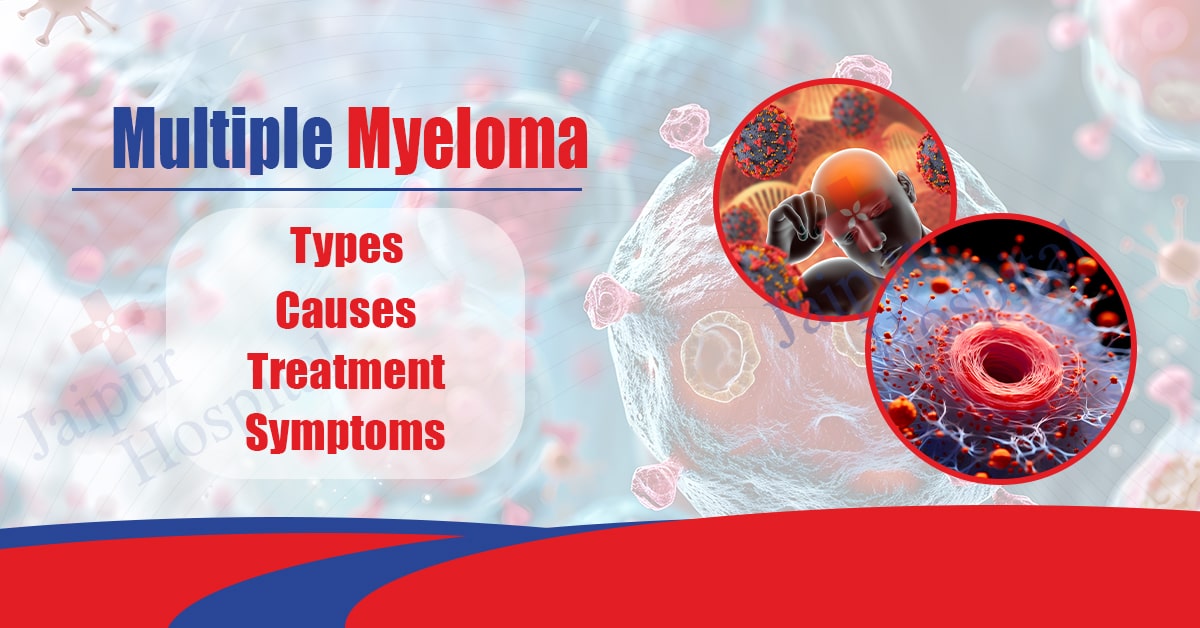Multiple Myeloma is a type of blood cancer originating in the plasma cells, a type of white blood cell found in the bone marrow. These cells are crucial for producing antibodies that help the body fight infections. In multiple myeloma, abnormal plasma cells proliferate uncontrollably, crowding out normal cells and leading to a variety of complications, including bone damage, anemia, kidney dysfunction, and a weakened immune system.
Although it is a relatively rare cancer, multiple myeloma is the second most common hematologic malignancy, primarily affecting older adults. Advances in treatment have improved outcomes, but the disease remains incurable, making ongoing research and clinical trials essential for developing more effective therapies.
What Is Multiple Myeloma?
Multiple Myeloma is a clonal plasma cell malignancy characterized by the uncontrolled proliferation of monoclonal plasma cells within the bone marrow. These malignant cells produce abnormal immunoglobulins, often called monoclonal proteins or M-proteins, which can be detected in the blood and urine.
The disease is associated with bone marrow infiltration, leading to bone lesions, anemia, hypercalcemia, renal impairment, and immune dysfunction. Multiple myeloma is considered a hematologic neoplasm and falls under the category of plasma cell dyscrasias, with a complex pathogenesis involving genetic abnormalities, microenvironmental factors, and interactions between malignant cells and the bone marrow stroma.
Symptoms of Multiple Myeloma
Multiple myeloma is a blood cancer affecting plasma cells in the bone marrow. Symptoms vary by disease stage and organ involvement, including:
- Bone Pain: Typically in the spine, ribs, or pelvis; persistent and worsens with movement.
- Frequent Infections: Due to a weakened immune system, leading to recurring infections like pneumonia or urinary tract infections.
- Fatigue: Resulting from anemia, causing persistent tiredness and weakness.
- Kidney Problems: Elevated calcium or protein levels can harm kidneys, leading to frequent urination, thirst, and leg swelling.
- High Calcium Levels (Hypercalcemia): Symptoms include nausea, vomiting, constipation, loss of appetite, confusion, increased thirst, and frequent urination.
- Anemia: Low red blood cells cause pallor, shortness of breath, and fatigue.
- Bone Fractures: Weak bones can become brittle and prone to fractures.
- Neurological Symptoms: Numbness or weakness, especially in the legs, and severe pain or paralysis due to spinal cord compression.
- Unexplained Weight Loss: Often due to the body’s response to cancer.
- Bleeding and Bruising: Low platelet counts lead to easy bruising and prolonged bleeding.
Types of multiple myeloma
Multiple myeloma is primarily categorized based on the characteristics of the myeloma cells and their behavior. Here are the main types:
- Smoldering (Asymptomatic) Multiple Myeloma
- Description: An early stage of multiple myeloma without symptoms.
- Characteristics: Abnormal plasma cells are present, but there is no organ damage or disease progression.
- Management: Typically monitored closely without immediate treatment.
- Active (Symptomatic) Multiple Myeloma
- Description: The most common form with noticeable symptoms.
- Characteristics: Evidence of organ damage, such as kidney issues, anemia, or bone lesions. High levels of M-protein are present in blood or urine.
- Management: Requires prompt treatment, which may include chemotherapy, targeted therapy, or stem cell transplant.
- Nonsecretory Multiple Myeloma
- Description: A rare form where myeloma cells do not produce detectable M-protein.
- Characteristics: Abnormal plasma cells are present, but M-protein levels are undetectable. Symptoms are similar to active myeloma but harder to track.
- Management: Treatment is akin to active myeloma, with a focus on imaging and bone marrow analysis.
- Light Chain Myeloma
- Description: Characterized by the production of only light chains, a component of antibodies.
- Characteristics: No intact M-protein, but excess light chains are present, often detected as Bence Jones proteins in the urine. Can lead to kidney issues.
- Management: Similar to active myeloma, with an emphasis on managing kidney function.
- IgD and IgE Myeloma
- Description: Rare subtypes based on the type of immunoglobulin produced (IgD or IgE).
- Characteristics:
- IgD Myeloma: More aggressive and often diagnosed at a later stage.
- IgE Myeloma: Very rare with unique clinical features.
- Management: Requires aggressive treatment due to the aggressive nature of these subtypes.
- Plasma Cell Leukemia
- Description: A rare and aggressive form with a high number of myeloma cells in the blood.
- Characteristics: Can be primary (arising de novo) or secondary (developing from multiple myeloma). Symptoms are similar to those of other leukemias.
- Management: Requires immediate and intensive treatment.
What Causes Multiple Myeloma?
The exact cause of multiple myeloma is not fully known, but it is believed to arise from a mix of genetic, environmental, and lifestyle factors:
- Genetic Mutations: Myeloma starts with mutations in a single plasma cell, leading to uncontrolled cell growth. Chromosomal abnormalities, such as translocations and deletions, also increase the risk by affecting cancer-related genes.
- Age: The likelihood of developing multiple myeloma rises with age, especially in those over 60, likely due to accumulating genetic mutations.
- Family History: A family history of multiple myeloma or related disorders can slightly elevate the risk, suggesting a genetic predisposition.
- Environmental Factors: Long-term exposure to chemicals like benzene and radiation, including from atomic bombs or radiation therapy, has been linked to a higher risk of myeloma.
- Chronic Inflammation or Infections: Ongoing immune system activation from chronic infections or autoimmune diseases may increase the risk by stimulating plasma cells and causing mutations.
- Monoclonal Gammopathy of Undetermined Significance (MGUS): MGUS, characterized by abnormal plasma cells and low M-protein levels, can sometimes progress to multiple myeloma.
- Obesity: Obesity is associated with a higher risk of developing multiple myeloma, possibly due to chronic inflammation and hormonal changes.
- Gender and Race: Men are slightly more likely to develop multiple myeloma than women, and African Americans have a higher incidence compared to other racial groups.
- Other Plasma Cell Disorders: Individuals with other plasma cell disorders or blood cancers may have an increased risk of multiple myeloma.
How do you diagnose myeloma?
Diagnosing multiple myeloma involves a combination of clinical evaluation, laboratory tests, imaging studies, and sometimes a biopsy. Here’s an overview of the diagnostic process:
- Medical History and Physical Exam
- Symptoms: The doctor will inquire about symptoms like bone pain, fatigue, infections, weight loss, or neurological issues.
- Physical Exam: May reveal signs such as bone tenderness, anemia, or other symptoms.
- Laboratory Tests
- Blood Tests:
- CBC: Assesses anemia and blood cell counts.
- Serum Protein Electrophoresis (SPEP): Detects abnormal proteins associated with myeloma.
- Immunofixation Electrophoresis: Further analyzes abnormal proteins.
- Serum Free Light Chain Assay: Measures free light chains that are often elevated in myeloma.
- Beta-2 Microglobulin: Indicates disease severity.
- Calcium and Creatinine Levels: Checks for kidney impairment and elevated calcium.
- Urine Tests:
- Urine Protein Electrophoresis (UPEP): Detects M-protein in urine.
- 24-Hour Urine Collection: Measures protein levels and assesses kidney damage.
- Imaging Studies
- X-rays: Identify bone lesions or fractures.
- MRI: Offers detailed images of bones and soft tissues.
- CT Scan: Detects bone destruction and masses.
- PET Scan: Identifies active disease and high metabolic activity.
- Bone Marrow Biopsy and Aspiration
- Procedure: A needle extracts bone marrow, typically from the hip, for microscopic analysis.
- Cytogenetic Analysis: Looks for genetic abnormalities in myeloma cells.
- Flow Cytometry: Identifies specific cell markers to confirm diagnosis.
- Staging and Risk Assessment
- Revised International Staging System (R-ISS): Stages the disease based on beta-2 microglobulin, albumin, LDH, and genetic abnormalities.
- Cytogenetic Tests: Detect high-risk genetic changes that influence prognosis and treatment.
- Differential Diagnosis
- Exclusion: Rules out similar conditions such as MGUS or Waldenström’s macroglobulinemia.
- Monitoring
- Repeat Testing: Ongoing tests to track disease progression and treatment effectiveness.
- Blood Tests:
Prognosis for myeloma
The outlook for multiple myeloma varies based on several factors:
- Factors Influencing Prognosis
- Disease Stage:
- Stage I: Best prognosis with low beta-2 microglobulin levels and no high-risk genetic features.
- Stage II: Intermediate prognosis.
- Stage III: Poorer prognosis with high beta-2 microglobulin levels and/or high-risk genetic abnormalities.
- Genetic Abnormalities:
- High-Risk: Includes chromosome 17p deletions and certain translocations (e.g., t(4;14), t(14;16)). These are linked to a more aggressive disease course.
- Standard-Risk: Better prognosis without high-risk genetic features.
- Response to Treatment:
- Complete Response: Better prognosis with no detectable disease post-treatment.
- Minimal Residual Disease (MRD) Negativity: Associated with longer survival.
- Relapsed/Refractory Disease: Generally has a less favorable prognosis.
- Patient Factors:
- Age: Younger patients often have better outcomes due to better tolerance for aggressive treatments.
- Overall Health: Comorbidities can impact treatment and prognosis.
- Treatment Advances:
- New Therapies: Advances in drugs and therapies (e.g., CAR-T cell therapy, monoclonal antibodies) have improved survival.
- Stem Cell Transplantation: Autologous transplants can extend remission and survival in eligible patients.
- Survival Rates
- Median Survival: Historically 3-5 years; now many patients live 7-10 years or more with modern treatments.
- 5-Year Survival Rate: Around 55%, varying with individual factors.
- Quality of Life
- Chronic Management: Often managed as a chronic condition with ongoing treatment to control symptoms and disease.
- Supportive Care: Important for managing symptoms like bone pain, anemia, and infections.
- Relapse and Refractory Disease
- Relapsed Myeloma: Disease may return after remission; treatment options are available but the prognosis may worsen with successive relapses.
- Refractory Myeloma: Resistant to treatment; generally has a poorer prognosis.
- Disease Stage:
Treatment for myeloma
Treatment for multiple myeloma involves a combination of therapies aimed at controlling the disease, managing symptoms, and prolonging survival. The specific treatment plan depends on factors such as the stage of the disease, the patient’s age and overall health, and the presence of certain genetic abnormalities. Here’s an overview of the main treatment options:
- Targeted Therapy: This method uses medications that specifically target certain substances within cancer cells. By inhibiting these substances, targeted therapies can induce the death of myeloma cells.
- Immunotherapy: This treatment utilizes drugs to enhance the body’s immune system, enabling it to better recognize and destroy cancer cells. Normally, cancer cells evade detection by the immune system, but immunotherapy helps the immune system to identify and attack these malignant cells.
- CAR-T Cell Therapy: Known as chimeric antigen receptor T cell therapy, CAR-T cell therapy involves modifying a patient’s T cells to better combat multiple myeloma. Initially, T cells are extracted from the patient’s blood and then altered in a laboratory to express specific receptors that recognize markers on myeloma cells. These engineered cells are then reintroduced into the patient’s body to target and eliminate the myeloma cells.
- Chemotherapy: This treatment employs potent medications to destroy cancer cells. Chemotherapy is effective against rapidly dividing cells, including those of myeloma.
- Corticosteroids: These medications help reduce inflammation and manage swelling, and they also have direct effects against myeloma cells.
- Bone Marrow Transplant: Also known as a stem cell transplant, this procedure replaces damaged bone marrow with healthy marrow. Blood-forming stem cells are collected before high-dose chemotherapy is administered to eradicate the diseased marrow. Subsequently, the collected stem cells are reinfused into the patient to regenerate healthy bone marrow. If the stem cells are sourced from the patient, the procedure is termed an autologous transplant; if they come from a donor, it is referred to as an allogeneic transplant.
- Radiation Therapy: This approach uses high-energy beams, such as X-rays or protons, to target and destroy cancer cells. Radiation can rapidly reduce tumors or masses, such as plasmacytomas, and is particularly useful for controlling localized pain or bone damage caused by myeloma cells.
Multiple Myeloma Risk Factors
Several factors can elevate the likelihood of developing multiple myeloma:
- Age: The disease is most commonly diagnosed in individuals in their late 60s.
- Gender: Men are at a higher risk compared to women.
- Race: Black individuals are more frequently affected by multiple myeloma compared to people of other races.
- Family History: Having a sibling or parent with multiple myeloma can increase one’s risk of developing the disease.
- Monoclonal Gammopathy of Undetermined Significance (MGUS): This condition, where abnormal proteins are present in the blood, can precede multiple myeloma and thus raises the risk of developing the disease.
Also read:- https://jaipurhospital.in/brain-aneurysm/
Complications
Multiple myeloma can lead to several complications, including:
- Infections: The disease impairs the immune system, reducing the body’s ability to combat infections.
- Bone Issues: It can cause bone pain, weaken bones, and increase the risk of fractures.
- Kidney Dysfunction: Multiple myeloma may adversely affect kidney function, potentially leading to kidney failure.
- Anemia: The proliferation of myeloma cells can crowd out healthy blood cells, resulting in a decreased red blood cell count and causing anemia.
Conclusion
In conclusion, multiple myeloma presents complex challenges with its varied prognosis and treatment options. However, advancements in therapies and a comprehensive approach to managing the disease have significantly improved patient outcomes. For those seeking exceptional care, Jaipur Hospital stands out as a premier Hospital in the fight against multiple myeloma.
Renowned for its state-of-the-art facilities and innovative treatments, Jaipur Hospital offers unparalleled expertise and cutting-edge solutions, ensuring that patients receive the highest standard of care. Its commitment to integrating advanced medical technologies with personalized treatment plans positions it as a leading center for managing multiple myeloma, providing hope and enhanced quality of life for those affected by this condition.


